
Heuchera ‘Southern comfort supplies color in December and throughout the winter in front of a dormant hydrangea in my garden.
Everyone loves color but it doesn’t have to come from flowers. There are several perennials that have lovely foliage color either in the fall or year-round. Before the hybridizers started playing with Heuchera (Alumroot), they were known for their green leaves and red or pink flowers. In the past ten years, however, we have been presented with Heuchera that boast rose, purple, peach, apricot, chartreuse, or bicolor foliage that changes from season to season. Many of these have H.villosa heritage and can take their place in the sun or the shade. Most of these cultivars have white flowers that bloom in the fall.
The ones that I have been growing in my garden for several years are rugged. They increase in size more quickly with average moisture but they still thrive in heat and drought. Even better, they are not bothered by deer although newly planted ones are sometimes dug up or eaten by other critters.
Talk about workhorses! After a few years, a clump is usually eighteen inches wide but only four inches high until it blooms and even then, the bloom stalks will only be twelve to eighteen inches tall. The ones that I use the most in my designs are ‘Georgia Peach’, ‘Southern Comfort’, and ‘Brownies’.
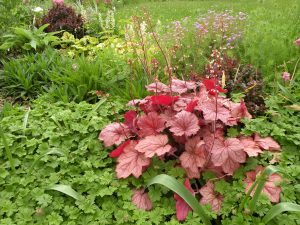
Heuchera ‘Georgia Peach’ in the sun in my garden in May adds lots of color before the other perennials start blooming. At its foot is Geranium cantabrigiense and behind it are a few purple-leafed barberries.
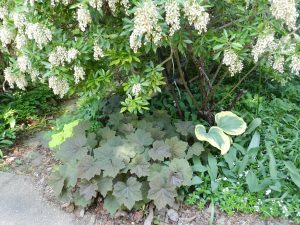
The large purple-tinged leaves of Heuchera ‘Brownies’ contrast well with the chartreuse leaves of Heuchera ‘Pistache’ and those of Hosta ‘Majesty in the spring but take stage during late fall through winter when the hosta has gone dormant and the Pieris in no longer in bloom.
‘Georgia Peach’ looks great during the growing season with Berberis ‘Golden Ruby’ and Hibiscus ‘Pinot Noir’ but when the Berberis and Hibiscus lose their leaves, ‘Georgia Peach’ is still holding the fort. When the wind blows, the underside of ‘Brownies’ foliage shows its purple color and it seeds quite a bit. I have some planted in partial shade under Pieris japonica with Hosta ‘Majesty’, a chartreuse and green cultivar. Another is planted on a south-facing hill with perennials that lose their leaves for the winter. ‘Southern Comfort’ looks great in the fall and winter when combined with any of the blue switchgrasses that turn yellow in the fall and then beige during the winter.
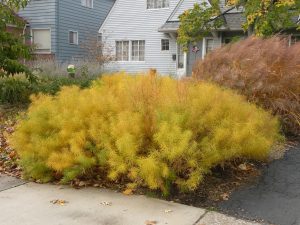
The golden tones of Amsonia hubrichtii and the bronze tones of Panicum ‘Northwind’ enliven the fall landscape even though all flowering has finished.
I love Amsonia hubrichtii (Arkansas Blue Star), the 2011 Perennial Plant Association Plant of the Year. It performs best in full sun and well-drained, average to moist soil but thumbs its nose at adverse conditions. Several years ago, I saw it as a bushy mass in mid-July on a Philadelphia campus when the area was in the midst of a long, dry, hot summer. Clusters of pale blue, star-shaped flowers bloom in June but this plant comes into its full glory in the fall when the feathery foliage turns a brilliant golden yellow.
Maintenance is minimal. Its three-foot stems never need staking and I merely cut back the old foliage to the base in early spring if it hasn’t fallen to the ground, in which case I leave it there as a natural mulch. A slow spreader, division will not be necessary for many years. Happily, it, too, is deer-resistant.
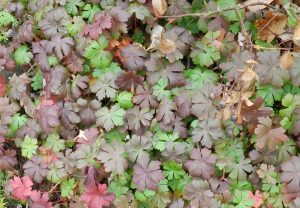
Geranium cantabrigiense adds another season of interest to the ground it covers with its reddish tinges during fall and winter.
Often overlooked for fall color is Geranium cantabrigiense ‘Biokovo’ or ‘Biokovo Karmina’. These short, hardy geraniums bloom their heads off in May, spread out their deeply cut and scalloped foliage during the summer, and then acquire reddish tones in the fall as temperatures drop. This species is an excellent groundcover for full sun or a half day of sun.
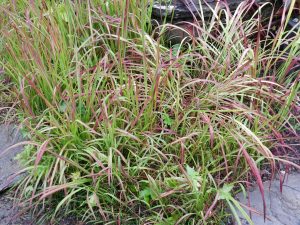
Panicum virgatum ‘Shenandoah’ in July already has pink tinges but they will deepen when temperatures drop in the fall.
Don’t forget about the color change of some ornamental grasses, especially the switchgrasses. The red ones, like Panicum virgatum ‘Rotstrahlbusch’ and ‘Shenandoah’, have a red tinge initially but it becomes much more pronounced in the fall. The blue switchgrasses become golden yellow in the fall. ‘Northwind’, in particular, is extremely sturdy and does not fall over, even in strong rains or snow.
Summer may be hot and dry but, although these plants survive beautifully without much rain, occasional watering will ensure that they retain their color well in the months into autumn. If you don’t already have some of them to give your gardens new exuberance for this fall when most people have given up on gardening, plan on adding them next spring.


0 Comments